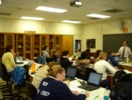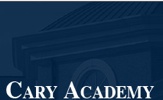I attended the first and second session of Ed Costello’s 4 sessions he will be having where he alerts the faculty to possible action items coming out of the years work that our Technology Task Force did in concert with the Technology Advisory Committees study of laptop programs around the country. I think our group worked well and was well served by Liz Coleman and Sheppy Vann’s leadership.
I thought I would blog about our proposals that will be put out for a vote in April of 2008.
Proposal 2: Set expectations and provide ample professional development opportunities and support
Training in the past has centered on using software with the hope that as teachers learned software they would bring it into their classroom. This method worked some of the time if the teacher had the time and inclination to take on creating a project using the software skills they had learned. Karen Lizska did this with her use of iMovie and her Spanish classes. I am sad to say that the overall training method has been a failure if we measure it on how much more technology is used by our teachers. Too many times we used the “Just in Case” method of training in that here is how you use Microsoft Word just in case someday you will need to use it. Excel was a program I taught this way to faculty members. If any learner does not use the skills they have learned they will quickly erode. Is that not why teachers have students do homework after new skills are taught – practice and use leads to a deeper understanding.
The methods for delivery at Durham Academy have ranged from Wired Wednesdays, Saturday Academy, Technology Mentors, GoLive Gurus, Vendor Delivered, and release time for teachers to work on lessons using the technology.
Our proposal will include something like the following. This is very FLUID so nothing is written in stone, so to speak.
Professional Development:
Teachers need to be supported with professional development that addresses best teaching strategies within the new learning environment. This training will be started in the year before students get their laptops and will include both in house and outside experts.
Divisions will coordinate the professional development they desire from outside vendors and in house integration specialists. Themes to address are reshaping curriculum using digital tools, enhancing curriculum by introducing an Interactive Learning Environment, and new strategies for teaching today’s student.
The professional development curriculum starts with attendance at three separate sessions covering the basic digital building blocks. This would occur during the summer in 3 to 4 day sessions in each area. By the beginning of school faculty would need to have their virtual learning environment established and populated with digital content. They would also need to have mapped their content delivery for the year using e-textbooks or on-line digital resources.
Once they have completed the basics, development would continue with 1-day training sessions each month. The training would focus on applications specific to their division. In the second year training would take place 3 times a year in daylong sessions. Release time will be given. Every 5 years the faculty person would need to attend a week-long summer immersion session to gain exposure to new applications and methods of using digital content. Technology use will be assessed as part of the overall professional evaluation process.
It is also recommended that technology aptitude be a condition of hiring new faculty. New hires must demonstrate experience using digital content in the classroom. This could be assessed during the hiring process by reviewing a digital portfolio of classroom content created by the prospective new hire.
Much like the new Real-time Learning page on our web site, we need to promote the new modes of teaching that colleagues do each day. A DA Technology Showcase should take place once a year so fellow teachers can see what colleagues are doing in their classrooms. This will aid in developing a mentor relationship between colleagues who are otherwise prone not to know about a technique or strategy.









